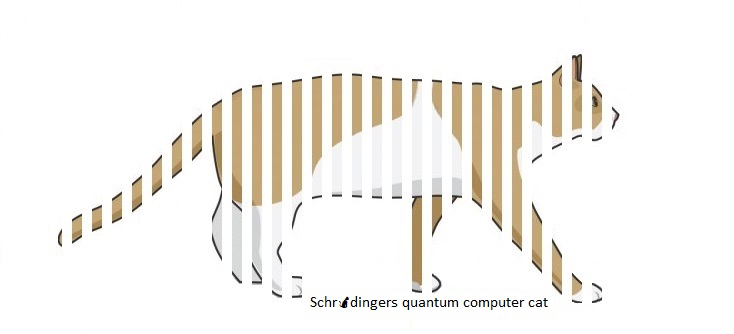Part 12, March 05, 2021 - Quantum computer (Reading time: 3 minutes)
Computers calculate with zeros and ones. They work with anything that can take on 2 states. With switches, relays, transistors or whatever, mechanical and electromechanical computers are feasible. Remember Konrad Zuse's legendary "Z3" from 1941, the world’s first working computer – built with relays.

When solid-state physicists began developing electrical circuit components made of semiconducting materials in the 1950s, computers became electronic. Transistors, diodes, etc. can be miniaturized straightforwardly.
But only up to the boundary between macro- and microphysics. Which has now almost been reached, as we can see from the fact that Moore's Law (doubling of the number of transistors on microchips roughly every 2 years) no longer applies.
If we want to make progress in computer development in future, we have to cross the border to microphysics. But: single molecules, atoms, the elementary particles, the "quanta" of the microphysical world, cannot be described with classical-visual physics we learned in school, but only with the abstract formalism called quantum mechanics, which is hardly or not at all accessible to human imagination.
„If you think you understand quantum mechanics, you don't understand quantum mechanics.“ This quote is attributed to the American physicist and Nobel Prize winner Richard Feynman (1918-1988). Undoubtedly made by Feynman, who was known for using gross words sometimes, is this call (1981): „Nature isn’t classical, dammit, and if you want to make a simulation of nature, you’d better make it quantum mechanical.“ Exactly 40 years ago, Feynman was already urging to construct quantum computers. But, actually, what is a quantum computer?
A classical bit as the smallest information unit can have 2 different states: 0 or 1 (power off / power on, magnetic north pole down / up, etc.). A quantum bit or "qubit" (also: "artificial atom") is described in quantum mechanics by so-called state functions. These can superimpose each other: the "superposition principle" of quantum mechanics allows states between 0 and 1. If we ask for a qubits actual state, we have to “see” for it, quantum physicists prefer to say “we have to measure it”. However, a quantum mechanical measurement influences the measured object, and the qubit will fall in one of the states 0 or 1.
The – theoretically achievable – superiority of a quantum computer results from the combination of qubits: 3 qubits are able to represent 2 to the power of 3 = 8 states, with 64 qubits it is 2 to the power of 64 = 18,446,744,073,709,600,000 states – simultaneously!
64 classical bits, as well, can represent 2 to the power of 64 states, but: only one at a time! To cycle through all of them (roughly 1 million terabytes) at today's typical computer speed (2 billion operations per second), would take some 400 years. This is what people mean when they say, that, one day, quantum computers will be able to tackle problems that are practically unsolvable for classical computers.
One more example: 160 qubits replace 10 to the power of 48 classical bits. A conventional computer with so many bits would weight 10 times the earth’s mass!
The computing power of quantum computers would outperform anything classical by far. Of course, this would make them an option for artificial intelligence. Which is why quantum computers and artificial intelligence are mentioned in the same breath sometimes. In contrast, more self-evident are quantum computer applications in materials research, where atomic and molecular states are to be calculated. A task that structurally couples to how quantum computers work.
But only … if we get a grip on the sensitive qubits. Even the smallest disturbance uncontrollably changes their states. That's why qubits must be confined at temperatures near absolute zero, in total darkness (Off limits to photons!), and/or in a vacuum. Quantum computers could not only compute super-fast, they would have to, because the qubit lifetime, their “coherence” persist only for a few seconds, even in extreme surrounding conditions. Moreover, qubit mathematics is error-prone. For each computing qubit, 1000 qubits are assumed to be needed for error correction.
Despite all this, or perhaps because of it, various approaches to the realization of quantum computers exist. However, quantum computers as well as computing time on quantum computers are already sold. Perhaps to make the first experts slowly familiar with the strange intellectual world of quantum computers. Whoever is first to have a foot in the door, is the technological leader, might be the slogan of marketing managers of the big competitors in quantum computers IBM, Google and Co.
Independent experts are more cautious in forecasting the development of quantum computers. A short search on the Internet shows: it will take some time before quantum computers can be used in meaningfully. Experts predictions range from 10 years, to 15, 20, 30 years, to “under no circumstances”.
What quantum computers already are able to manage today, again, suits to their operation modes: generating random numbers. They add two unknown numbers, the sum is pure coincidence and the result changes again when it is read out from qubits. Errors don’t matter, the precise result isn’t required, only its randomness.
Is Schroedinger’s cat, locked in a box that contains a lethal radioactive substance, still alive? We only figure it out, if we take a look into the box (as said before: we “measure” the cats state). Before, the state of the cat is undetermined: she lives and she is dead. It’s the same with quantum computers: they are there and they are not there – simultaneously!
The next time you hear about quantum computers, sit back for 10 years or for good. And enjoy the functionality and reliability of your true Industrial PC from Omtec!
